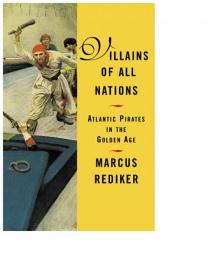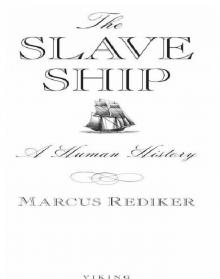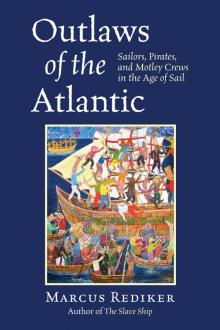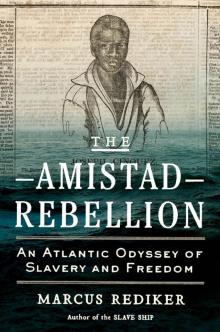- Home
- Marcus Rediker
Villains of All Nations
Villains of All Nations Read online
ALSO BY MARCUS REDIKER
Between the Devil and the Deep Blue Sea: Merchant Seamen, Pirates, and the Anglo-American Maritime World, 1700–1750
The Many-Headed Hydra: Sailors, Slaves, Commoners, and the Hidden History of the Revolutionary Atlantic (with Peter Linebaugh)
To learn more about Marcus Rediker and his work, please visit http://www.MarcusRediker.com.
Villains of All Nations
ATLANTIC PIRATES IN THE GOLDEN AGE
MARCUS REDIKER
Beacon Press, Boston
In memory of
Michael Jiménez (1948–2001)
and
Steve Sapolsky (1948–2001)
Contents
1. A Tale of Two Terrors
2. The Political Arithmetic of Piracy
3. Who Will Go “a Pyrating”?
4. “The New Government of the Ship”
5. “To Do Justice to Sailors”
6. The Women Pirates: Anne Bonny and Mary Read
7. “To Extirpate Them Out of the World”
8. “Defiance of Death Itself”
Conclusion: Blood and Gold
Notes
Acknowledgments
Index
1. A Tale of Two Terrors
IN THE EARLY AFTERNOON of July 12, 1726, William Fly ascended Boston’s gallows to be hanged for piracy. His body was nimble in manner, like a sailor going aloft; his rope-roughened hands carried a nosegay of flowers; his weather-beaten face had “a Smiling Aspect.” He showed no guilt, no shame, and no contrition. Indeed, as attending minister Cotton Mather noted, he “look’d about him unconcerned.” But once he stood on the gallows, he became concerned, although not in the way anyone might have expected. His demeanor quickened, and he immediately took charge of the stage of death. He threw the hanging rope over the beam, made it fast, and carefully inspected the noose that would go around his neck. He soon turned to the hangman in disappointment and reproached him “for not understanding his Trade.” But Fly, a sailor who knew the art of tying knots, took mercy on the novice. He offered to teach him how to tie a proper noose. Then Fly, “with his own Hands[,] rectified Matters, to render all things more Convenient and Effectual,” retying the knot himself as the multitude who had gathered around the gallows looked on in astonishment. He informed the hangman and the crowd that “he was not afraid to die,” that “he had wrong’d no Man.” Mather explained that he was determined to die “a brave fellow.”1
When the time came for last words on that awful occasion, Mather wanted Fly and his fellow pirates to act as preachers—that is, he wanted them to provide examples and warnings to those who were assembled to watch the execution.2 They all complied. Samuel Cole, Henry Greenville, and George Condick, perhaps hoping for a last-minute pardon, stood penitently before the crowd and warned all to obey their parents and superiors and not to curse, drink, whore, or profane the Lord’s day. These three pirates acknowledged the justice of the proceedings against them, and they thanked the ministers for their assistance. Fly, however, did not ask for forgiveness, did not praise the authorities, and did not affirm the values of Christianity, as he was supposed to do, but he did issue a warning. Addressing the port-city crowd thick with ship captains and sailors, he proclaimed his final, fondest wish: that “all Masters of Vessels might take Warning by the Fate of the Captain (meaning Captain Green) that he had murder’d, and to pay Sailors their Wages when due, and to treat them better; saying, that their Barbarity to them made so many turn Pyrates.”3 Fly thus used his last breath to protest the conditions of work at sea, what he called “Bad Usage.” He would be launched into eternity with the brash threat of mutiny on his lips. Mather took pleasure in detecting what he thought was a slight tremor in the malefactor’s hands and knees, but Fly nonetheless died on his own terms, defiantly and courageously. The ministers and magistrates of Boston, however, had reserved for themselves the last lines of the drama. If Fly would not warn people in the ways they deemed proper, they would do it themselves, and in so doing they would answer his threat. After the execution, they hanged Fly’s body in chains at the entrance of Boston Harbor “as a Spectacle for the Warning of others, especially Sea faring Men.”4
High drama had surrounded Fly and his crew from the moment they were brought into port as captives on June 28, 1726. Fly was a twenty-seven-year-old boatswain, a poor man “of very obscure Parents,” who had signed on in Jamaica in April 1726 to sail with Captain John Green to West Africa on the Elizabeth, a snow (two-masted vessel) based in Bristol. Green and Fly soon clashed, and the boatswain began to organize a mutiny against Green’s command. Fly and another sailor, Alexander Mitchell, roused Green from his sleep late one night, forced him on deck, beat him, and attempted to throw him over the side of the ship. When Green caught hold of the mainsheet, one of the sailors picked up the cooper’s broad ax and chopped off the captain’s hand at the wrist. Poor Green “was swallowed up by the Sea.” The mutineers then turned the ax on Thomas Jenkins, the first mate, and threw him, still alive, overboard after the captain. They debated whether their messmate, the ship’s doctor, should follow them into the blue, but a majority of the crew decided he might prove useful and confined him in irons instead.5
Figure 1. The hanging of pirate captain Stede Bonnet, Charleston, November 1718; Captain Charles Johnson, A General History of the Robberies and Murders of the Most Notorious Pyrates (London, 1724).
Having taken possession of the ship, the mutineers prepared a bowl of punch and ceremoniously installed a new shipboard order of things. These sailors, who routinely sewed canvas sails and were therefore expert with needle and thread, stitched a skull and crossbones onto a black flag, creating the Jolly Roger, the pirates’ traditional symbol and instrument of terror. They renamed their vessel the Fames’ Revenge and sailed away in search of prizes. They captured five vessels. After taking the John and Hannah off the coast of North Carolina, Fly punished its captain, John Fulker, by tying him to the geers and lashing him before sinking his ship. Fly’s piratical adventures came to an end when a group of men he had forced aboard the pirate ship from prize vessels rose up and captured him. Fly and his crew were brought into Boston Harbor to stand trial for murder and piracy.6
Awaiting them in Boston was the Reverend Doctor Cotton Mather, the pompous, vain, and overbearing sixty-three-year-old minister of Old North Church who was probably the most famous cleric, maybe even the most famous person, in the American colonies at the time.7 Mather took a personal interest in the case, vowing to bring Fly to salvation. He met with the former bosun, exhorted him to reform and repent, and commanded him to go to church. Benjamin Colman, another leading minister, joined the struggle to save Fly’s soul, but it was all to no avail. Boston’s most eminent men of the cloth failed miserably with their prisoner, who defied them, mocked them, and raged against them. Colman wrote that Fly “fell at times into the most desperate ragings ... cursing the very heavens & in effect the God that judged him.”8 Mather concluded that Fly was “a most uncommon and amazing Instance of Impenitency and Stupidity, and What Spectacles of Obduration the Wicked will be.” At one of these meetings Fly had exploded in anger, “I can’t Charge myself,—I shan’t own myself Guilty of any Murder,—Our Captain and his Mate used us Barbarously. We poor Men can’t have Justice done us. There is nothing said to our Commanders, let them never so much abuse us, and use us like Dogs. But the poor sailors—” At this point Mather apparently interrupted; he could bear to hear no more. Two discourses, one Christian and providential and the other maritime and social, came together in a cosmic clash.9
The hanging of the “poor man” William Fly was a moment of terror. Indeed, it might be said that the occasion represented a clash of two dif
ferent kinds of terror. One was practiced by the likes of Cotton Mather—namely, ministers, royal officials, wealthy men; in short, rulers—as they sought to eliminate piracy as a crime against mercantile property. They consciously used terror to accomplish their aims: to protect property, to punish those who resisted its law, to take vengeance against those they considered their enemies, and to instill fear in sailors who might wish to become pirates. This they did in the name of the social order, as suggested by Colman, whose execution sermon (which Fly refused to attend) was a meditation on terror, on God as “the king of terrors” and hence the source of all social discipline. In truth, the keepers of the state in this era were themselves terrorists of a sort, decades before the word terrorist would acquire its modern meaning (as it would do in the Reign of Terror during the French Revolution). And yet we do not think of them in this way. They have become, over the years, cultural heroes, even founding fathers of sorts. Theirs was a terror of the strong against the weak.10
The other kind of terror was practiced by common seamen like William Fly who sailed beneath the Jolly Roger, the flag designed to terrify the captains of merchant ships and persuade them to surrender their cargo. Pirates consciously used terror to accomplish their aims—to obtain money, to punish those who resisted them, to take vengeance against those they considered their enemies, and to instill fear in sailors, captains, merchants, and officials who might wish to attack or resist pirates. This they did in the name of a different social order, as we will see in the chapters that follow. In truth, pirates were terrorists of a sort. And yet we do not think of them in this way. They have become, over the years, cultural heroes, perhaps antiheroes, and at the very least romantic and powerful figures in an American and increasingly global popular culture. Theirs was a terror of the weak against the strong. It formed one essential part of a dialectic of terror, which was summarized in the decision of the authorities to raise the Jolly Roger above the gallows when hanging pirates: one terror trumped the other.11
The dramas involving pirates—William Fly and the dozens of others we will meet in the pages that follow—concerned the fundamental issues of the age. As we will see, poor seamen who turned pirate dramatized concerns of class. Formerly enslaved Africans or African Americans who turned pirate posed questions of race. Women who turned pirate called attention to the conventions of gender. And all people who turned pirate and sailed under “their own dark flag,” the Jolly Roger, enacted a highly political play about the nation. These events had their own theater, in both senses of the word—a specific geography and a particular dramatic form. They took place around the Atlantic, on the hastily constructed scaffolds of port-city gallows as in Boston, and on the heaving decks of deep-sea ships, as on the Fames’ Revenge. The stages were transient, in motion, and simultaneously local and global, as were the subjects who acted on them.12
In the national drama, the pirate took the stage as a fierce and forbidding villain, described by ruling groups as a blood-lusting monster bent on destroying the social order. Beneath the rhetoric of demonization, which we explore in chapter 7, lay an actual history of national challenge and consequence. Some seafaring contemporaries of William Fly had worked during the War of Spanish Succession as privateers—that is, they labored in private men-of-war, with commissions from the King, to attack, capture, and plunder enemies in wartime. Leaders of European nations used privateers to supplement naval power, to disrupt supply lines and commercial circuits, and to accumulate wealth at the expense of their rivals. But when the war ended, they found that they could not control the privateers they had once employed. In 1716 a gang of pirates, for example, announced, boldly and self-importantly, that “they never consented to the Articles of Peace with the French and Spaniards” and would therefore continue to attack their ships. This very crew, captained by Benjamin Hornigold, added that “they meddle not with the English or Dutch.”
Governor Alexander Spotswood of Virginia had heard such claims by and about pirates, but he did not believe them. In July 1716 he wrote to the Council of Trade and Plantations that the pirates who had recently congregated in the Bahama Islands had announced that they would not be “disturbing the English, and that they will only content themselves with making Prize of all French and Spanish they meet with.” He continued: “yet there is so little trust to be given to such People, that it is not to be doubted they will use all Nations alike whenever they have an advantage.” He was right. The logic of privateering would not hold for long. An astonished Hornigold would soon discover this for himself: his own, mostly English crew ousted him for refusing to take and plunder English vessels, which were, after all, the most plentiful and lucrative ships to be found in the seas they sailed.13
In a world increasingly dominated by the nation-state system, it became an issue of first importance that pirates “had not any Commission from any Prince or Potentate.” After a bloody engagement in which HMS Swallow, a man-of-war, captured the crew of Bartholomew Roberts off the coast of West Africa in 1722, a judge sternly lectured the pirates in the emergency court set up in Cape Coast Castle, a slave-trading fortress; they had, he explained, “made this Fight and insolent Resistance Against the King’s Ship, without any Pretence of Authority more than that of your own private depraved Wills, but did it also under a Black Flag, flagrantly by that denoting Your selves as common Robbers, Opposers, and Violators of all Laws humane and divine.”
Pirates did not consider themselves “common Robbers, Opposers, and Violators of all Laws humane and divine,” but they did think of themselves as people without a nation. When pirates stitched together their black flag, the antinational symbol of a gang of proletarian outlaws, they “declared War against all the World.” When hailed by another ship, pirates, who were multinational in origin, usually answered that they came “from the seas,” not from any particular country. Some pirates explained to captives that they had “sold their nation” for booty. They made the point with brutal clarity after the declaration of war against Spain (the brief War of the Quadruple Alliance) in March 1719, when the British admiralty and royal officials throughout the Americas desperately hoped that pirates would come in, accept the King’s commissions, and go back to sea as privateers. Many pirates did come in, did accept commissions, and did go back out as privateers—in the employ of Spain, to attack British ships! Historian Peter Earle writes that Spanish “privateers were said to be manned mainly by the subjects of Great Britain and France, another instance of the extreme disloyalty of the pirates of this period.” The leaders of the nation would conclude that such people had to be exterminated.14
The pirates of the 1710s and 1720s were among the greatest ever in the long history of robbery by sea. They stood at the very pinnacle of what is called the golden age of piracy, which spanned the period from roughly 1650 to 1730. This era featured three distinct generations of pirates: the buccaneers of 1650–80, the mostly Protestant sea dogs of England, northern France, and the Netherlands, exemplified by the Jamaica raider Henry Morgan, who hunted wild game on deserted islands and attacked the ships of Catholic Spain; the pirates of the 1690s, the generation of Henry Avery and William Kidd, who moved into the Indian Ocean and built a pirate base on the island of Madagascar; and finally the subjects of this book, the pirates of the years 1716–26, who were the most numerous and successful of the three. They were epitomized by Edward Teach and Bartholomew Roberts, who attacked the ships of all nations and created a crisis in the lucrative Atlantic system of trade. They also generated most of the images of pirates that live on in modern popular culture, from swashbuckling figures such as Blackbeard, to the unnamed, unlimbed pirate who was the likely model for Robert Louis Stevenson’s Long John Silver in Treasure Island, to the dreaded black flag with skull and bones, the Jolly Roger.
The multiethnic freebooters of 1716–26 numbered around four thousand over the decade. They wreaked havoc in the Atlantic system by capturing hundreds of merchant ships, many of which they burned or sank, and all of which they
plundered of valuable cargo. They disrupted trade in strategic zones of capital accumulation—the West Indies, North America, and West Africa—at a time when the recently stabilized and expanding Atlantic economy was the source of enormous profits and renewed imperial power. Usually sailors joined pirate ships after working on merchant and naval ships, where they suffered cramped quarters, poor victuals, brutal discipline, low wages, devastating diseases, disabling accidents, and premature death. Piracy, as we will see, offered the prospect of plunder and “ready money,” abundant food and drink, the election of officers, the equal distribution of resources, care for the injured, and joyous camaraderie, all as expressions of an ethic of justice.
Piracy may have held out hope for a good life, but it was not to be a long one. The typical man sailed under the black flag for a year or two, and many if not most pirates lost their lives for it. Unusual was the man who served—or lasted—longer. The royal officials who prosecuted the crew of Roberts at Cape Coast Castle referred to the first group to be hanged, William Magnes, David Sympson, Thomas Sutton, Valentine Ashplant, and Richard Hardy, as “old Standers and notorious Offenders” even though each had been “upon the account” for only three to four years. Yet the danger of death was no deterrent for many, and indeed the choice was summed up by Captain Roberts himself, who remarked that in the merchant service “there is thin Commons, low Wages, and hard Labour; in this, Plenty and Satiety, Pleasure and ease, Liberty and Power; and who would not ballance Creditor on this Side, when all the Hazard that is run for it, at worst, is only a sower Look or two at choaking. No, a merry Life and a short one, shall be my motto.”15

 Villains of All Nations
Villains of All Nations The Slave Ship
The Slave Ship Outlaws of the Atlantic
Outlaws of the Atlantic The Amistad Rebellion
The Amistad Rebellion